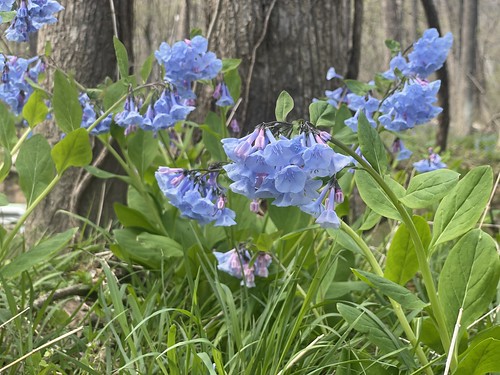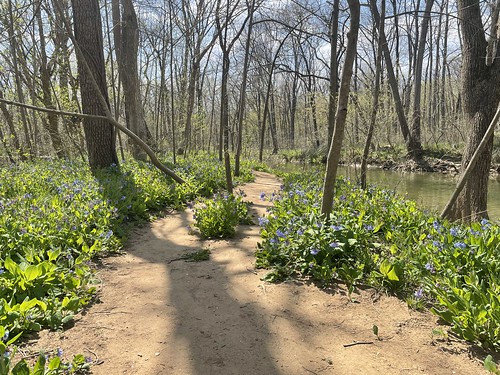Open fires are prohibited throughout the park from midnight to 4 p.m. through April 30 per the 4 p.m. Burning Law. This includes wood and charcoal. Gas is permissible. Campground fires are allowed during the restricted time if a camp host is on duty and signage to that effect is posted in the campground. Failure to observe the 4 p.m. Burning Law can result in a fine. Contact the Park Office for additional information.
Read Our Blogs
Tiptoe 'Round the Bluebells
Shared by Sean Kelly- AmeriCorps (Bay Experience Program), as Guest Blogger.
If you asked a group of life-long Virginians to name a blue flower unique to our state, they might be at a loss. Certainly, there are many Virginians with a strong interest in native plants or flowers who would immediately answer "bluebells!"
That said, many native Virginians have lived in the Commonwealth their whole lives, yet they've never heard or seen these beauties. Why? I suspect one reason is that they are not commonly found in cultivated gardens.
Another, perhaps the more significant reason is that they are spring ephemeral flowers: they bloom only for a short few weeks in early spring. Outside of their brief blooming period, they wouldn't capture our attention most of the year. But at Shenandoah River State Park, they put on quite the display!

While filming and photographing Virginia Bluebells as part of my duties as an AmeriCorps member, several park visitors remarked on the fairy-tale quality they give to the atmosphere. I couldn't agree more, and suggest that you find a way to see them in person!
According to Kevin McDonald, Assistant Park Manager at Shenandoah River, visitors can expect to see them in all their splendor until around mid-April At this point, the blooms will start to disappear. But if you can't make it in time this year, you can at least enjoy a few of our photos and facts about them!
While "blue" is a part of their name, Virginia Bluebell flowers begin as pink buds that shift to blue as they grow and open. Occasionally you might even find a fully formed flower that is white. However, this is quite rare: in many hours photographing them, neither I nor my Bay Experience Program partner Lyra Bartell, ever found one. (If you do, assume that it is a great omen and share it with us!)

The flower's name also betrays its form: like an elongated, conical bell. This unique shape, along with its downward-facing orientation, makes it a bit difficult for bumblebees to hover and get to the pollen inside. Therefore, most pollination occurs through butterflies.
But pollination is only one part of it. How do new bluebell flowers spread and grow? If you go to Shenandoah River State Park, you'll notice that you can find bluebells all around the banks of the river as well as nearby depressions. This spreading is due to the seeds saying goodbyes to their mother plants when water from nearby rivers or streams flood them. The water both dislodges and carries seeds downstream.
Once some plants establish themselves on a bank, they grow as a rhizome, similar to ginger or bamboo.

If you make it to Shenandoah River State Park to check out their beautiful bluebells or visit any of our wonderful state parks at this time of the year, it is critical that you stay on established trails.
Ephemerals like Virginia Bluebells are one of the big reasons why sticking to established trails is so essential. We all want to capture the best shot of these beauties when they're in bloom, but we don't want to accidentally crush them and therefore ruin both our view as well as this crucial native plant's chances at survival. (Let's not have a California poppy-fields moment!)
Yet even at other times of the year, this part of Leave No Trace ethics remains equally, if not more important. Just think: if most of us saw one of these beautiful blooms, we'd be very careful to avoid harming it. Yet what if we saw the flowerless plant two weeks before blooming or two weeks after? They wouldn't demand our attention in the same way.
Walking off-trail often leads to stepping on all kinds of plants that may not catch our eye but could be a vital part of our ecosystem. You wouldn't want to crush a little Virginia Bluebells' dreams of blooming one day, would you? Of course, you wouldn't!

So, if you're ready, plug Shenandoah River State Park into your GPS, grab your hiking boots and optional walking stick, and get ready to be amazed. And if you're not? I hope you've enjoyed the photos, learned a little, and have the chance to see them in real life one day. Perhaps I've planted a seed in your mind that they're well worth a special trip!
If you have read the article and have a question, please email nancy.heltman@dcr.virginia.gov.
Search for blogs
By Park
Categories
Cabins
Camping
Fishing
History and Culture
Other
Programs and Events
Trails
Volunteers
Water Fun
Archive
2024
2023
2022
2021
2020
2019
2018
2017
2016
2015
2014
2012














